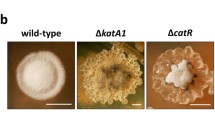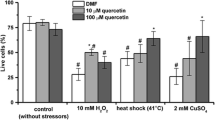Abstract
Cysteine metabolism with the subsequent release of anionic thiols has been shown to be involved in yeast cell morphogenesis of the dimorphic, pathogenic fungus Histoplasma capsulatum. Following transfer to fresh medium, intracellular thiol levels during the initial 2–4 h appear to determine the eventual growth form. Mild oxidative stress induced by paraquat (methyl viologen) caused enhanced intracellular and extracellular thiol production and an increase in protein thiol formation. Mildly stressed cells continued to grow in the yeast form. Severe oxidative stress induced by high concentrations of paraquat resulted in lowered thiol production as well as reversion to the alternate mycelial morphology. These results suggest that thiol modulation of intracellular protein status may be involved in morphogenesis of H. capsulatum.
Similar content being viewed by others
References
Bochner BR, Lee PC, Wilson SW, Cutler CW, Ames BN. AppppA and related adenylylated nucleotides are synthesized as a consequence of oxidative stress. Cell 1984; 37:224–32.
Bradford MM. Arapid and sensitive method for the quantitation of microgram quantities of protein utilizing the principle of protein-dye binding. Anal Biochem 1976; 72:248–54.
Bus JS, Cagen SZ, Olgaard M, Gibson JE. A mechanism of paraquat toxicity in mice and rats. Toxicol Appl Pharmacol 1976; 35:501–13.
Cohn VH, Lyle J. A fluorometric assay for glutathione. Anal Biochem 1966; 14:434–40.
DiMonte D, Ross D, Bellomo G, Eklow L, Orrenious S. Alterations in intracellular thiol homeostasis during the metabolism of menadione by isolated rat hepatocytes. Arch Biochem Biophys 1984; 235:334–42.
DiMonte D, Bellomo G, Thor H, Nicotera P, Orrenius S. Menadione-induced cytotoxicity is associated with protein thiol oxidation and alteration in intracellular Ca2+ homeostatis. Arch Biochem Biophys 1984; 235:343–50.
Garrison RG, Dodd HT, Hamilton JW. The uptake of low molecular weight sulfur-containing compounds by Histoplasma capsulatum and related dimorphic fungi. Mycopath Mycol Appl 1970; 40:171–80.
Gilbert HE Biological disulfides: the third messenger? J Biol Chem 1982; 257:12086–91.
Hames BD. An introduction to polyacrylamide gel electrophoresis. In: Hames BD, Rickwood D, eds. Gel electrophoresis of proteins. Oxford: IRL Press, 1981:1–91.
Hazen KC. Release of sulfhydryl compounds by the pathogenic fungus Histoplasma capsulatum. Curr Microbiol 1986; 14:45–50.
Hazen KC, Hazen BW. Thiol production and release by the dimorphic fungus Histoplasma capsulatum (Abstract). Annual Meeting of the American Society for Microbiology 1985:375, 1985.
Lambowitz AM, Kobayashi GS, Painter A, Medoff G. Possible relationship of morphogenesis in pathogenic fungus, Histoplasma capsulatum, to heat shock response. Nature 1983; 303:806–8.
Maresca B, Lambowitz AM, Kumar VB, Grant GA, Kobayashi GS, Medoff G. Role of cysteine in regulating morphogenesis and mitochondrial activity in the dimorphic fungus Histoplasma capsulatum. Proc Natl Acad Sci USA 1981; 78:4596–600.
McVeigh I, Houston WE. Factors affecting mycelial to yeast phase conversion and growth of the yeast phase of Histoplasma capsulatum. Mycopathologia 1972; 47:135–51.
McVeigh I, Morton K. Nutritional studies of Histoplasma capsulatum. Mycopathologia 1965; 24:294–309.
Nickerson WJ. Symposium on biochemical basis of morphogenesis in fungi. IV. Molecular basis of form in yeasts. Bacteriol Rev 1963; 27:305–24.
Nickerson WJ, Mankowski Z. Role of nutrition in the maintenance of the yeast shape in Candida. Am J Bot 1953; 40:584–92.
Rippon JW. Monitored environment system to control cell growth, morphology, and metabolic rate in fungi by oxidation-reduction potentials. Appl Microbiol 1968; 16:114–21.
Salvin SB. Cysteine and related compounds in the growth of the yeastlike phase of Histoplasma capsulatum. J Infect Dis 1949; 84:275–83.
Stetler DA, Boguslawski G. Cysteine biosynthesis in a fungus, Histoplasma capsulatum. Sabouraudia 1979; 17:23–34.
Wardlaw AC. Practical statistics for experimental biologists. Chichester: John Wiley and Sons Ltd, 1985:84–6.
Author information
Authors and Affiliations
Rights and permissions
About this article
Cite this article
Leith, K.M., Hazen, K.C. Paraquat induced thiol modulation of Histoplasma capsulatum morphogenesis. Mycopathologia 103, 21–27 (1988). https://doi.org/10.1007/BF00437217
Accepted:
Issue Date:
DOI: https://doi.org/10.1007/BF00437217




